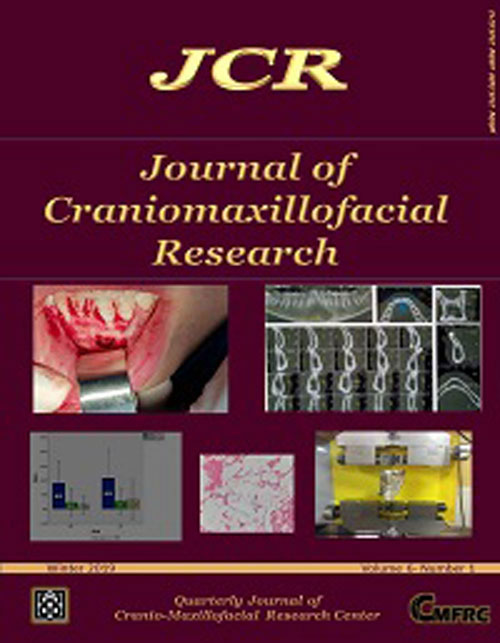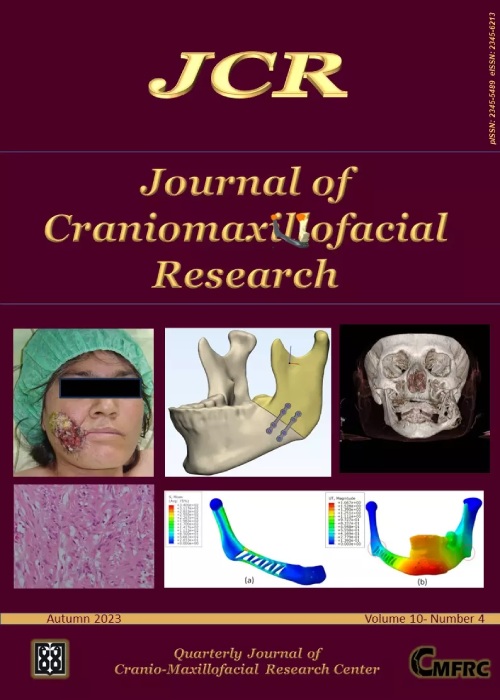فهرست مطالب

Journal of Craniomaxillofacial Research
Volume:6 Issue: 2, Spring 2019
- تاریخ انتشار: 1398/07/21
- تعداد عناوین: 6
-
-
Pages 55-59Background
Currently one of the most common problems in dentistry is effective pain management after dental surgeries. Celecoxib is the only specific COX-2 inhibitor used in Iran.
AimThe aim of this study was to determine the effectiveness of Celecoxib (an Iranian product) and Celebrex in pain relief after periodontal surgery.
Materials and MethodsThis randomized double-blind cross-over clinical trial was conducted on 30 patients with chronic periodontitis. The patients underwent surgical procedures on two posterior symmetric sextant with a 4-week interval. The patients were assigned to 2 groups:Group A: 200mg of Celebrex under the brand name, (bid) and group B:200 mg of Celecoxib (bid). The patients reported their pain level using VAS (visual analog scale) 1, 3, 6, 12, 24 and 48 hours after periodontal surgery. Data were analyzed with SPSS 15, using Mann-Whitney and Freidman’s tests.
ResultsStatistical analysis of data showed significant differences between Celecoxib and Celebrex 1, 3, 6, 12 and 24 hours after surgery (P<0.05). In each group there were significant differences between different postoperative intervals (P<0.05).
ConclusionConsidering the lower rate of side effects of COX-2 specific inhibitors, if the patients have no financial problems, Celebrex can be a proper choice for pain management after periodontal surgeries.
Keywords: Celecoxib, Cyclooxygenase-2 inhibitors, Pain management -
Pages 60-65Objective
The purpose of this study was to evaluate the survival rate and the amount of periimplant bone loss in implants placed in free iliac graft following segmental mandible resection.
Materials and MethodsOver a 5-year period between 2010 and 2015, nine patients with odontogenic tumors who were candidate for segmental mandible resection were enrolled in this study. Resection defect was immediately reconstructed with non-vascularized iliac graft and 4-6 months later 36 implants of 5 different brands were inserted in grafted mandibles. Information regarding implant survival, peri implant bone loss or inflammation for a mean follow up period of 33 months was obtained.
ResultsOne implant was failed out of 36 implants and the cumulative survival rate of implants was 97.2% in this follow up period. There was no sign of peri implant inflammation or gingival recession or BOP in any patients. The cervical bone loss level varied between 0.6 to 12mm (the length of failed implant) with the average of 0.96 mm. The bone loss level of survived implants varied between 0.6to 1.72mm with average of 0.64mm.
ConclusionThis study demonstrated that reconstruction of segmental mandibular defect with non vascularized iliac graft followed by dental implant placement is an effective and predictable method to restore oral function.
Keywords: Implant, Non vascularized iliac graft, Segmental resection, Survival, Cervical boneloss -
Pages 66-72Objectives
This study aimed to measure the buccal cortical plate thickness in the mandible of dentate adults in an Iranian population using cone-beam computed tomography (CBCT).
Materials and MethodsEighty CBCT images were evaluated in this study using NNT Viewer 6.0 software. Images had high-resolution and had been taken by NewTom CBCT scanner with 11 x 8cm field of view. Measurements were made using the digital ruler of the software with 0.1mm accuracy. All analyses were performed by two observers: an oral and maxillofacial radiologist and a general dentist. In case of disagreement between the observers, measurements were repeated and the mean value was used for analysis. Data were analyzed by using linear regression.
ResultsThe results showed that the thickness of buccal cortical plate increased from the canine towards the second molar site. The second molar site had the greatest density and thickness. Gender had a significant effect on the thickness of buccal cortical plate (P<0.05) but the effect of right/ left quadrant was not significant (P>0.05). The effect of age on this thickness was insignificant in some (P>0.05) and significant (P<0.05) in some other areas such that by an increase in age of patients, this thickness decreased (i.e. at the apex of canine, second premolar and second molar teeth).
ConclusionThe buccal cortical plate thickness of the mandible increases from the anterior towards the posterior region, and the second molar area has the greatest thickness and density suitable for placement of orthodontic mini-implants or harvesting autogenous grafts.
Keywords: Buccal cortical plate, Mandible, Cone-beam computed tomography, Mini-implant -
Pages 73-79Objective
Evaluation of the quality of education and the relevant curriculum is one of the most important steps for optimizing the educational process. One of the ways to address the quality control is to continuously assess the postgraduate students’ opinions. This study aimed to evaluate satisfaction of senior postgraduate students of oral and maxillofacial surgery with the specialty curriculum.
Materials and MethodsThe target population in the present cross-sectional study consisted of all the senior postgraduate students in the field of oral and maxillofacial surgery all over Iran during the 2016−2017 educational year. The research questions consisted of 3 questions on demographic variables and 23 on educational variables, the characteristics of clinical education (including physical conditions and the number and varieties of the patients), the possibility of access to academic sources, the independent activity of post graduate students in taking history, the quality of educational activity of the professors, the quality of hospital wards and their interest in their field of study.
ResultsThe mean age of the post graduate students was 32.4±3.8 and 93.5% % were male. Among the post graduate students, 58.1% were fully satisfied and 41.9% were moderately satisfied with the curriculum. A total of 64.5% of the post graduate students were fully satisfied with theoretical lessons, while 32.3% and 3.2% exhibiting moderate and low satisfaction rates, respectively. For practical training, 61.3% of the post graduate students were fully satisfied and 38.7% exhibited a moderate level of satisfaction. In clinical training, 7.38% of the post graduate students reported full satisfaction, while 58.1% and 3.2% reporting moderate and low rates of satisfaction, respectively. A total of 58.1% of the post graduate students were moderately satisfied with the facilities available and 41.9% reported a low satisfaction rate. Satisfaction was the same among females and males.
ConclusionSince the educational curricula and the educational facilities have been designed for high-quality education of the post graduate students, it is necessary to take the necessary steps to revise the curricula and improve the educational facilities.
Keywords: Educational curriculum, Oral, maxillofacial surgery, Satisfaction -
Pages 80-84
This technical note aims to introduce a new approach for intubation of patients with restricted mouth opening in cases that conventional and fiberoptic-assisted endotracheal intubation are not possible. The proposed technique is a modification to the previously well-established retrograde intubation method. The main advantage of this new technique is the employment of fiberscope for direct visualization which eliminates the use of guide wire. The endotracheal tube enters through the nostril and is railroaded using the fiberscope as a guide. Using this new technique can prevent the complications of tracheostomy and the traditional retrograde intubation in patients that anterograde intubation is not feasible. The promising result of conducting the intubation with this approach can be considered the basis for future clinical investigation.
Keywords: Fiberscope, Modified retrograde intubation, Direct visualization -
Pages 85-87
Subcutaneous emphysema of the face is an uncommon complication caused by dental procedures such as curettage, root canal treatment, extraction, restorative treatment and dental instruments like air-water syringe and hand piece. Subcutaneous emphysema can be life threatening if involved the spaces of neck and superior mediastinum. In this rare case, subcutaneous emphysema of the face was developed after potential removal of an amalgam tattoo with the help of an excavator. The patient was completely recovered after three days of timely medical treatment.
Keywords: Celecoxib, Cyclooxygenase-2 inhibitors, Pain management


